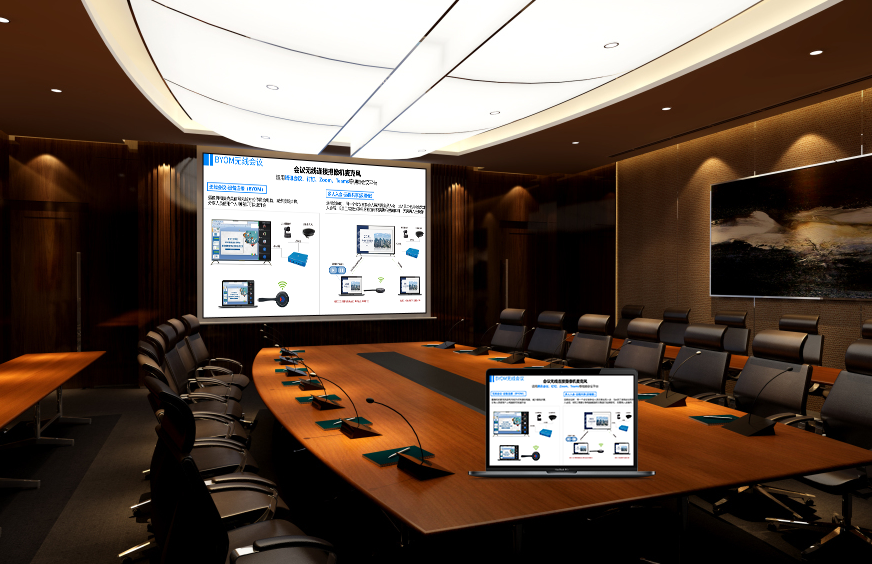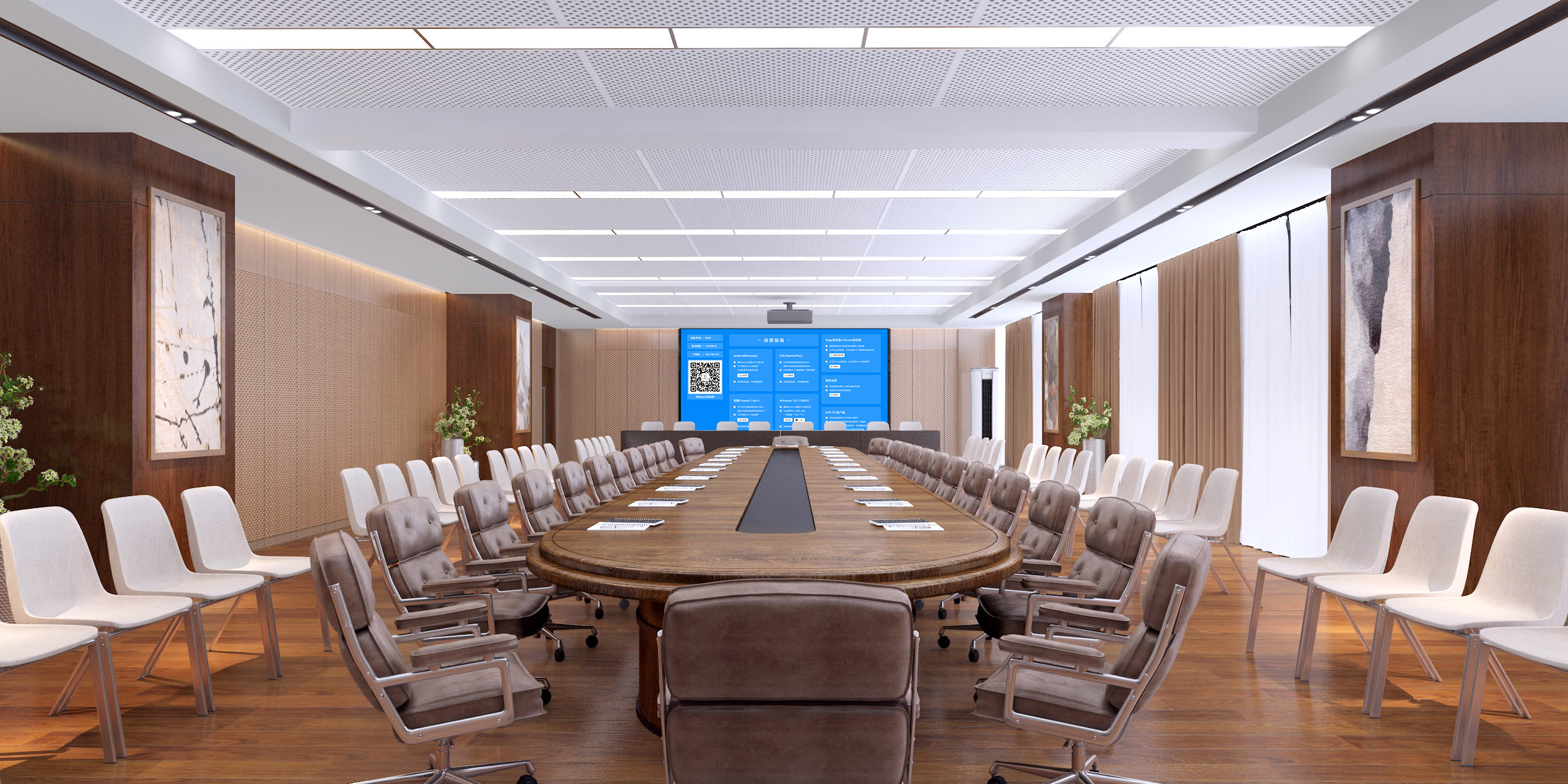DLNA: Flexible Targeted Casting
Tired of having to mirror your entire screen, which hogs your device and makes it hard to cast specific content? This device is fully compatible with the DLNA protocol, letting you target specific content like documents, videos, and audio from your computer or phone to a big screen. It’s perfect for business presentations, home entertainment, and training sessions. This feature transforms screen casting from a “full synchronization” to an “on-demand push,” making multitasking more efficient.
Two Simple Steps for Targeted Casting
No complicated settings needed. Just follow these steps for a precise cast:
- Quick Device Connection: Plug the receiver into a big screen (conference screen, TV, or projector) and power it on. The screen will display a unique DLNA name (like “Conf. Room A – DLNA” or “Living Room Media”). Make sure the casting device (computer or phone) is on the same network as the receiver. There’s no need to install drivers or plugins—the system automatically recognizes the protocol.
- Select and Cast: On your computer, right-click a document, video, or audio file, select “Cast to Device,” and then choose the correct screen name. On your phone, tap the “DLNA Push” icon in your file manager or media player and select the device. The cast is complete in just one second. You can then use your device for other tasks without being tied to the casted content.
Key Advantages: DLNA Casting Tailored to Your Needs
Multitask Without Tying Up Your Screen
Unlike full-screen mirroring, DLNA only sends the specific content you select (like a single PowerPoint slide, an MP4 video, or an MP3 file). After casting, you can edit documents, chat, or browse for information in the background without the casted content taking over your screen, making it great for both work and play.
It also supports simultaneous casting from multiple devices. For example, one computer can cast a presentation to the main screen while another phone casts a reference video to a side screen. This dual-screen setup complements the information you’re showing and prevents a single screen from being overwhelmed with too much data.
Universal Format Compatibility
The device is perfectly compatible with all major DLNA-supported formats, so you can directly cast documents (PPT, PDF, Word, Excel), videos (MP4, MKV, AVI), audio (MP3, WAV), and images (JPG, PNG) without needing to convert them first.
For common office tasks, the device supports a “page-by-page cast” function for presentations, so you can push one slide at a time to avoid revealing what’s coming next. For videos, it remembers your progress, so you can pick up where you left off after a pause. This makes training and presentations feel more professional and fluid.
Cross-Device Compatibility
This device works with computers running Windows 7 and above, macOS 10.10 and above, and phones/tablets with Android 4.2+ and iOS 9+. It has a compatibility rate of over 98% with major brands like Lenovo, HP, Apple, Huawei, and Xiaomi, so even older devices can cast smoothly.
You don’t need to install a special app on your devices. The system uses built-in DLNA features (like “Cast to Device” on Windows, “Media Share” on Android, and an “AirPlay” compatibility mode on iOS), which means the experience is lightweight, doesn’t take up memory, and is perfect for businesses that restrict software installation.
Real-World Scenarios: Super Practical DLNA Casting
Meetings and Presentations: Professional and Flexible
When giving a report, you can use DLNA to cast your presentation from your computer to the main screen. Once you’re done, you can open an Excel spreadsheet in the background to pull up key data on the fly. If a client wants to see a product video, you can cast it from your phone to a side screen while the main presentation continues, so your flow isn’t interrupted.
In a collaborative meeting, one person can cast a document from their computer to the main screen, another can cast a data chart to a secondary screen, and a third can cast live photos from their phone to a small screen. This three-screen setup helps focus the discussion and boosts efficiency by 50%.
Home Entertainment: Immersive and Uninterrupted
While your family watches a movie you’ve cast to the TV using DLNA, you can continue to browse social media or chat on your phone without the cast being affected. If your child is taking an online class, they can cast the video to the TV for a bigger, eye-friendly view while using their tablet in the background to take notes and look up information.
When you have friends over, everyone can take turns casting photos and videos to the TV using DLNA. The person casting is free to switch the music or send messages on their device, which makes for a more relaxed and interactive atmosphere.
Training and Education: Keep the Focus
A trainer can use DLNA on their computer to cast a training presentation to the main screen, while simultaneously preparing quizzes in the background. For key chapters, they can cast a case study video from their phone to a side screen, allowing trainees to see both the main presentation and a real-world example at the same time.
During practical lessons, a trainer can cast a document with step-by-step instructions from their computer to the big screen, while casting a demonstration video from a second tablet. If students have questions, the trainer can use their phone to cast a diagram or photo to the screen. This multi-content approach enhances the learning experience.
Practical Details: A Convenient Casting Helper
Stable and Interference-Resistant: Using dual-band (2.4GHz + 5.8GHz) transmission, DLNA casting has a low latency of just 20ms. Video playback is smooth and audio stays in sync, even with many devices connected at home or in a crowded office.
Remembers Your Devices: After the first cast, the device automatically remembers frequently used screens and prioritizes them in the future. This saves you time since you won’t have to search for the device repeatedly.
Portable and Easy to Carry: The receiver is small enough to fit in the palm of your hand and weighs less than 40g. You can easily slip it into your bag when traveling for work, so you can set up a DLNA casting session at a client’s office or a training venue anytime, anywhere.
Whether you need to cast specific documents for work, play media at home, or use multiple materials for a training session, this device’s DLNA function frees you from the limitations of full-screen mirroring. Every cast is precise, and every task is more flexible, truly making your content work for you.